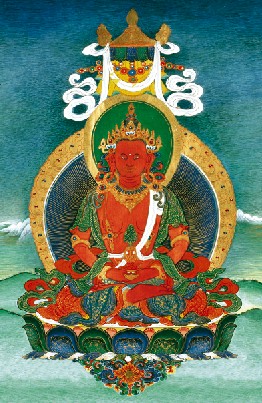Long life practice: Difference between revisions
mNo edit summary |
mNo edit summary |
||
| Line 5: | Line 5: | ||
===Brief Teaching by Orgyen Tobgyal Rinpoche=== | ===Brief Teaching by Orgyen Tobgyal Rinpoche=== | ||
All sentient beings have as the ground of their being, the [[sugatagarbha]], due to which they can attain enlightenment. If there were no potential for enlightenment, there would not really be such a special point made about living a longer life. | All [[sentient beings]] have as the ground of their being, the [[sugatagarbha]], due to which they can attain enlightenment. If there were no potential for enlightenment, there would not really be such a special point made about living a longer life. | ||
If you are to attain [[enlightenment]], then you require a physical form. It is said that the form of a human being is the best form among the [[six classes of beings]]. The ‘boat’ of the human body is very good for crossing the ‘river’ of suffering. This is an important point. But we will not find this boat again and again. So now that we have it, we should not waste our time in laziness and sleep. | If you are to attain [[enlightenment]], then you require a physical form. It is said that the form of a human being is the best form among the [[six classes of beings]]. The ‘boat’ of the human body is very good for crossing the ‘river’ of suffering. This is an important point. But we will not find this boat again and again. So now that we have it, we should not waste our time in laziness and sleep. | ||
Revision as of 11:26, 7 September 2008

Long Life Practice (Tib. tsé drup; Wyl. tshe sgrub) is an important aspect of vajrayana practice, employing the skilful means of the secret mantra in order to increase one's own or others' lifespan. Long life practices are often focused on deities specifically associated with longevity, such as Amitayus, the Buddha of Boundless Life, White Tara or Ushnishavijaya (Tib. Namgyalma)—known collectively as the 'three deities of long life'—Tsendali, the consort of Amitayus, or Thangtong Gyalpo.
See also tenshyuk and tsé guk.
Brief Teaching by Orgyen Tobgyal Rinpoche
All sentient beings have as the ground of their being, the sugatagarbha, due to which they can attain enlightenment. If there were no potential for enlightenment, there would not really be such a special point made about living a longer life.
If you are to attain enlightenment, then you require a physical form. It is said that the form of a human being is the best form among the six classes of beings. The ‘boat’ of the human body is very good for crossing the ‘river’ of suffering. This is an important point. But we will not find this boat again and again. So now that we have it, we should not waste our time in laziness and sleep.
Guru Rinpoche said:
- "As the first of all activities,
- The vidyadhara should achieve longevity!
- Of all activities, the first should be long-life practice.
- If life is long, it can be virtuous,
- And the purpose of this life and the next can be achieved."
So it is good to live a long life because we can fully accomplish the purpose of this and future lives.
In terms of the methods for prolonging life, the buddhas, who are skilled in means and possess great compassion, have taught many different ways. They have taught both common and supreme methods for extending life.
Common methods include ‘extracting the essence’ (chü len) and taking medicinal substances, and methods employing the breath and special yogic exercises. You find a lot about medicine and how to make pills for long-life and so on in the terma teachings. Among the uncommon methods, there is deity visualization, mantra recitation, and dzogrim practice.
If the common methods can be combined with supreme, uncommon methods then life will naturally be extended. So when we do long-life practice we bring together the common and uncommon techniques. If, for example, we make long-life pills, which is a common method, then we combine that with the uncommon methods of visualizing the deities and blessing the substances, so that the two levels are combined.
Since longevity is so important, there is no tertön who has not revealed methods for long-life practice. Some revealed as many as five or six different practices, some two or three. So there are many long-life sadhanas.
Therefore, if you are a practitioner of the Dharma, someone who is putting the teachings into practice, there is great significance to doing long-life practice. If you are not a Dharma practitioner, but just someone caught up in worldly life, then there is not such great purpose to living a long time. Here we are talking from the point of view of a practitioner.
These long-life practices bring the two together: common and uncommon. We achieve longevity as the ordinary accomplishment, but in the process, we also achieve the supreme accomplishment. In the best case, we achieve the rainbow body. If not, then by living for eighty or ninety years, we become a good practitioner whose realisation is as vast as space, and who is able to work for his or her own and others’ benefit.
Every one of us needs to do long-life practice. And we need to do a practice that combines common and uncommon methods. For this you need an explanation on how to practise.
(From a teaching by Orgyen Tobgyal Rinpoche)